- Broad compatibility
- Easy device recognition
- Alexa skills
- Good sound quality
- Closed cabinet operation
- Universal remote
- Amazon recently redesigned its Echo smart speakers, but they don't ship until October 22, 2020. We've added some information about these new products in the Amazon Echo reviews below and plan to update our guide with these new products after release.
- Google announced a redesign of their Google Home smart speaker, now called the Google Nest Audio. We plan to evaluate this speaker in our upcoming smart speaker review.
- If This Then That (IFTTT) recently introduced a subscription plan (about $10 a month) that adds new features to this excellent smart home service. Unfortunately, the free plan lost most of the things that made IFTTT worthwhile for smart homes.
Bottom line: Bring it all together with Samsung SmartThings
One of the most important questions when you’re shopping for a smart home hub is “Will it work with my devices?” The 3rd generation Samsung SmartThings Hub earned our top pick because more often than not, the answer to that question was “yes” with this hub.
It works with Zigbee, Z-Wave, Wi-Fi, and Bluetooth. It’s a little bit cheaper than its past versions because the cloud-to-cloud protocols require less memory space and it doesn’t have a backup battery. Also, you don’t need to connect it to your router using a cable, so you can put it pretty much anywhere.
Find out how it compares to the competition in our full breakdown of the best smart hubs.
Compare the best smart home hubs
| List price* |
| Connection type |
| Smart home compatibility (partial list) |
|
Best compatibility
|
Best voice controls
|
Best for media
|
Budget Alexa hub
|
Budget Google hub
|
| Samsung SmartThings (3rd Gen) |
Amazon Echo Plus (2nd Gen) |
Logitech Harmony Hub | Amazon Echo Dot (3rd Gen) |
Google Nest Mini |
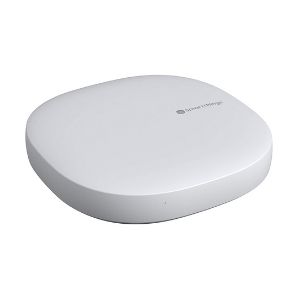 |
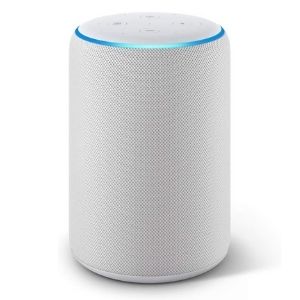 |
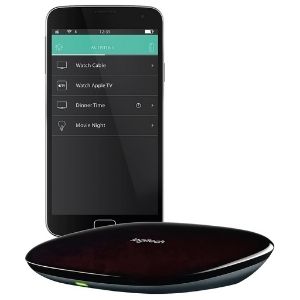 |
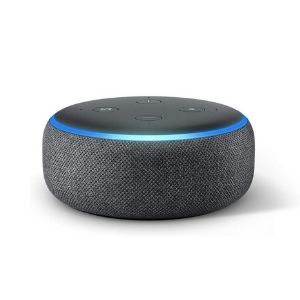 |
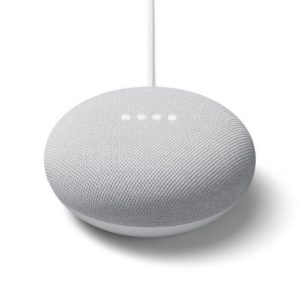 |
| $89.99 | $149.99 | $99.99 | $49.99 | $49.00 |
| Bluetooth Wi-Fi Z-Wave Zigbee |
Bluetooth Wi-Fi Zigbee |
Bluetooth Wi-Fi Infrared |
Bluetooth Wi-Fi |
Bluetooth Wi-Fi |
| Alexa, Arlo, August, Bose, Cree, Ecobee, GE, Google Assistant, Honeywell, Kwikset, Leviton, LIFX, Philips Hue, Ring, Schlage, Sylvania, Yale | Alexa, Arlo, August, Ecobee, GE, Honeywell, Kwikset, LIFX, Lutron, Nest, Philips Hue, Schlage, SmartThings, Sylvania, TP-Link, WeMo, Yale | Alexa, Apple TV, Google Assistant, PlayStation, Roku, Sonos, Wii, Xbox | Alexa, Arlo, August, Ecobee, GE, Honeywell, Kwikset, LIFX, Lutron, Nest, Philips Hue, Schlage, SmartThings, Sylvania, TP-Link, WeMo, Yale | August, Cree, Ecobee, GE, Google Home, Honeywell, Leviton, LG, LIFX, Nest, Philips Hue, SmartThings, Sylvania, TP-Link, WeMo |
| View on Amazon | View on Amazon | View on Amazon | View on Amazon | View on Kohl's |
| Read review | Read review | Read review | Read review | Read review |
*Amazon.com list price as of 10/01/2020 at 4:00 p.m. (MT). Read full disclaimer.
Our approach
To select the best smart home hubs, we focused on choosing hubs that were compatible with the most brands and easy to use. We studied real user reviews and compared product features side by side in hands-on tests. Read our full methodology to find out more.
Best smart hubs reviews
1. Samsung SmartThings (3rd Gen): Best compatibility
Having a Samsung SmartThings Hub is kind of like traveling the world with a multilingual friend. It breaks down communication barriers and helps you and your devices all communicate better together, giving you a fully integrated smart home system.
Unlike other smart home hubs that require you to scan in the QR codes from all your devices, the Samsung SmartThings scans for your devices’ signals on its own—it might even discover smart products you didn’t even know you had!
Pros
- Android and iOS compatibility
- Easy setup
- Routines and scenes
- Multiple communication protocols
- Independence from router
Cons
- Not compatible with Nest
- Connectivity issues
If you use Google Assistant† or an Amazon Alexa device, the Samsung SmartThings is compatible with both. The Samsung app manages all your devices in one place, so you can create routines and “scenes” for certain times, like when you first wake up in the morning or when you leave the house.
The app is a little slow to open, and we noticed that some non-Samsung brand devices tend to have some connectivity issues, but overall it’s a solid choice for multiple device integration.
Read our full Samsung SmartThings review.
2. Amazon Echo Plus (2nd Gen): Best voice controls
The Amazon Echo Plus takes the Echo family further into smart home integration by adding a Zigbee-enabled smart home hub. It supports Zigbee, Wi-Fi, and Bluetooth smart home devices. Use it to call people hands-free or ask Alexa to read the news, answer questions, and play music.
It can also work like a home intercom system with other Amazon Echo devices in your house. If you’re like me and you don’t want your smart home hub to look like an alien spaceship that landed in the middle of your home, you’ll appreciate the variety of different finishes offered by the Echo Plus to blend in to your décor.
Pros
- Voice control
- Alexa skills
- Different finishes
- IFTTT compatibility
Cons
- Incompatible with some devices
- Disappointing sound quality
The second generation Echo Plus is touted as having better sound quality than its predecessor, with 360-degree Dolby speakers and a mini woofer for better bass performance. But many users who have upgraded say that the sound quality actually falls short when compared to the original Echo Plus.
Check out some of our favorite Alexa-compatible devices.
The end of the Echo Plus
3. Logitech Harmony Hub: Best for media
The Logitech Harmony Hub is for folks that dream of dimming the lights, powering up the surround sound, and starting a blockbuster movie on your big screen with a single tap. You can use the hub to design scenes like “movie night” with custom settings for each device to follow when it activates.
It works with both Amazon Alexa and Google Assistant so you can use your voice to connect to your set-top box to change channels or adjust the volume on your TV. If you prefer a quieter interaction, the Harmony app turns your phone or laptop into a universal remote, and IR blasters (they’re like an infrared remote control) can control up to eight different devices, even with those devices behind closed cabinet doors.
Pros
- Closed cabinet control
- Universal remote
- Voice control
- Computer app access
- Favorite channels
Cons
- Incompatibility with Z-Wave and Zigbee
- Challenging setup
Unfortunately, the Harmony Hub can’t connect to radio communication protocols like Zigbee or Z-Wave devices, and it controls only up to eight devices with its IR blaster. But you can pair it with another hub for added functionality if needed. For a full color touchscreen remote that controls up to 15 devices, check out the Logitech Harmony Elite (about $270).
4. Amazon Echo Dot (3rd Gen): Budget Alexa hub
The Amazon Echo Dot is a lot less expensive than traditional hubs and still performs many of the same functions, like giving you Alexa integration and voice control for your smart home devices.
It costs a third of the price of the Echo Plus, so you can expect lower sound quality and no built-in Zigbee controls, but the Alexa voice assistant still answers your questions, plays your music, and gives you access to thousands of other skills.
New version coming soon
5. Google Nest Mini: Budget Google hub
Like the Echo Dot, the Google Nest Mini isn’t much of a hub, but it offers similar features like controlling your smart home devices using your voice. It’s compatible with a wide variety of smart lights, plugs, appliances, and home security products.
We found that Google Assistant is a little bit better at recognizing voice commands than Alexa, and we like the option for using less specific follow-up questions, like asking, “When does it open?” after asking where the nearest bakery is.
Check out some of our favorite Google Assistant-compatible devices.
More hubs we considered
Broadlink
The Broadlink RM4 Pro (about $45) is a cheaper universal remote alternative to Logitech Harmony. Its IR/RF technology allows you to control a wide variety of devices using your smartphone. While Harmony has a focus on entertainment devices like TVs and stereo systems, Broadlink expands beyond that to also control appliances like air conditioners and fans, provided they already use some sort of remote control.
Hubitat
The Hubitat Elevation (about $150) is a powerhouse of a smart hub, easily beating SmartThings in user privacy and customization options. But it’s mostly for hardcore smart home enthusiasts since it’s more difficult to set up. Plus it’s one of the more expensive hubs on the market.
Wink
The Wink Hub 2 (about $100) was one of the earliest smart home hubs to hit the market and it remains a compelling alternative to SmartThings. We like its native support for Nest and Lutron smart devices, both of which don’t work with SmartThings. Unfortunately, Wink’s products have become less reliable and harder to find in stock. Plus its recent move to a monthly fee makes it a poor choice for folks on a budget.
Final word
The Samsung SmartThings Hub is our top smart hub pick thanks to its compatibility with an overwhelming number of smart devices. We especially like how you can just press “discover all my devices” in the app and the SmartThings hub does the rest for you. The only real downsides to this hub were that it’s not compatible with Nest thermostats and it’s not always as reliable as we’d like.
Smart home hub FAQ
What should I look for in a smart hub?
Always look at the compatibility, mobile app, and setup when choosing a smart home hub:
- Compatibility: Make sure the devices are compatible with each other to avoid buying additional hubs or new devices. If you already have connected devices in your home, choose a hub that connects with them as well as future devices on your wishlist. Take a close look at the hub’s website before you buy—it’s fairly easy to find a full list of compatible devices.
- Mobile app: As you shop for a hub, read app reviews from users, and if you can, test drive different automation hubs. You want a user-friendly app that’s easy to navigate while interacting with your devices.
- Setup: Most smart home hubs walk you through setup using tutorials and guides. It’s nice to have help setting up your hub and other devices in this growing market with lots of unknowns.
If all my devices connect through my Wi-Fi network, do I need a smart home hub?
Technically, no, and it can be tempting to rely on Wi-Fi enabled smart gadgets and apps to avoid a hub setup altogether. Wi-Fi is fine for wired smart devices like bulbs, plugs, and smart doorbells, but it quickly drains the batteries of your wireless devices like security sensors or door locks.
Having too many can also drag down your network speed. If you want to avoid frequent battery replacement and keep your Wi-Fi network running smoothly, it’s worth it to look into wireless devices that use radio frequencies like Z-Wave and Zigbee.
Can I link multiple smart hubs together?
Yes. You may have some hubs that speak one language, and some that speak another, and that’s okay. As you learn more about how home automation works and get more comfortable with your system, you may discover more gadgets that don’t work with your current hub.
In that case, you can use another hub or a bridge to loop them into your smart home system.
Can security systems work as smart home hubs?
Yes, the “brains” of some of the best smart home security systems also operate as smart home hubs and give you control of your smart home gadgets through your security system app.
If you want voice control, look for a system that’s compatible with a voice assistant, and you’ll be able to access devices like your Ring video doorbell with your voice. Security system hubs can also offer you the added bonus of cellular and battery backups in case of power outages.
Contributing writer: John Carlsen
Related articles
- The Best Smart Home Security Systems
- What Is Home Automation and How Does It Work?
- Best Smart Tech Tools: How to Work from Home Like a Boss
- Ultimate Guide to Alexa and the Amazon Echo Family
- Ultimate Guide to Google Assistant and Google Nest Products
- Room-by-Room Guide to Home Automation
- What’s the Difference between Zigbee and Z-Wave?
Disclaimers
*Amazon.com list price as of 10/01/2020 at 4:00 p.m. (MT). Product prices and availability are accurate as of the date/time indicated and are subject to change. Any price and availability information displayed on Amazon at the time of purchase will apply to the purchase of this product. Safewise.com utilizes paid Amazon links.
Certain content that appears on this site comes from Amazon. This content is provided “as is” and is subject to change or removal at any time.
†Google, Google Nest, Google Assistant, and other related marks are trademarks of Google LLC.
The post 2020’s Best Smart Home Automation Systems appeared first on SafeWise.
Article source here: 2020’s Best Smart Home Automation Systems
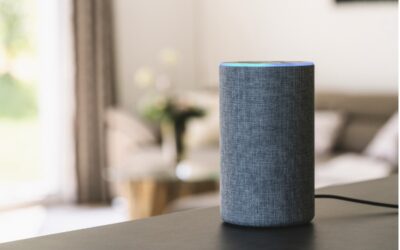
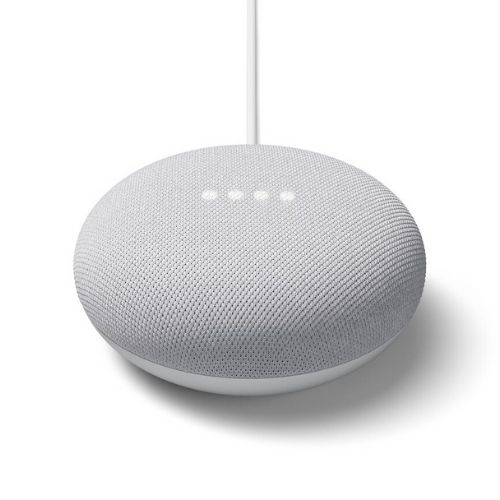
No comments:
Post a Comment